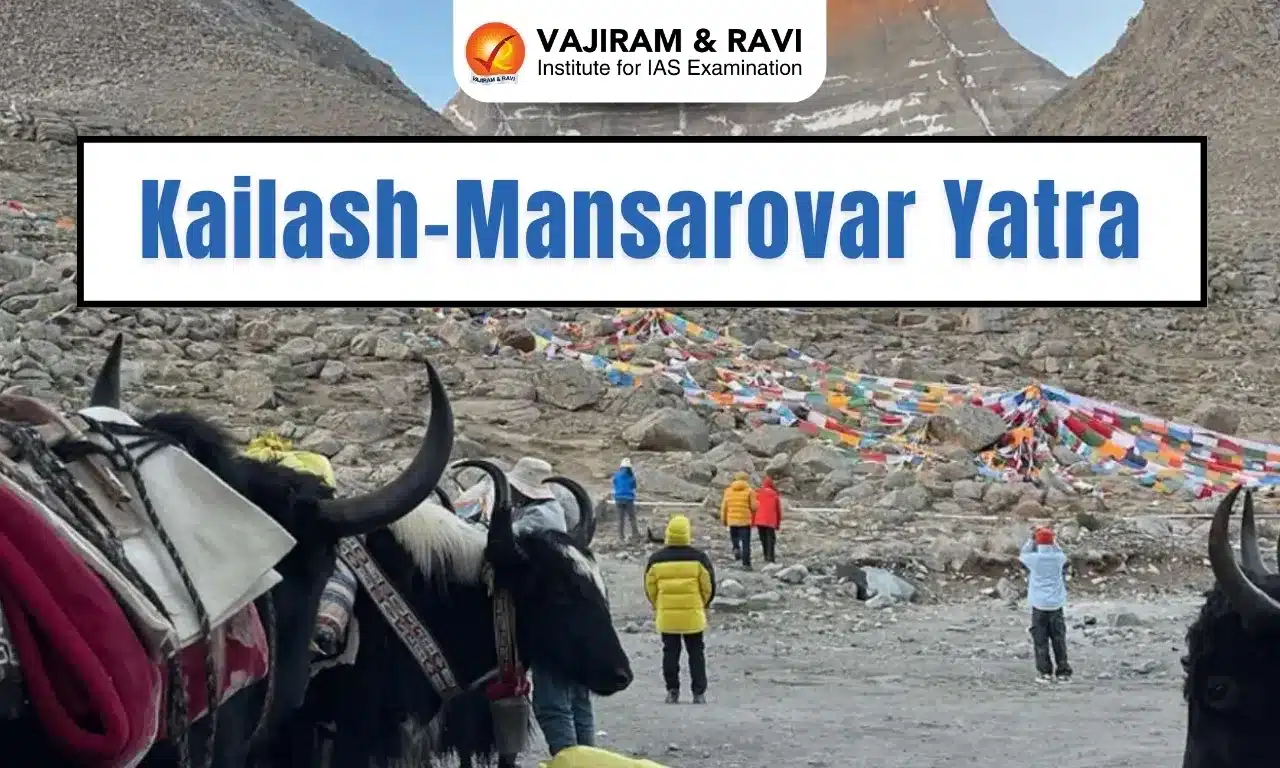Kailash-Mansarovar Yatra Latest News
- After a five-year pause due to Covid-19 and India-China tensions, the Kailash-Mansarovar yatra resumed in 2025.
- This year, 750 pilgrims were selected by the Ministry of External Affairs.
- Five batches of 50 pilgrims each are travelling via Uttarakhand’s Lipulekh Pass, while 10 batches of 50 each are using Sikkim’s Nathu La Pass.
Mount Kailash and the Sacred Lakes: Spiritual and Geographical Significance
- Rising 6,638 metres in Tibet’s Ngari Prefecture near India and Nepal, Mount Kailash holds deep religious importance for Hindus, Buddhists, Jains, and Tibetan Bon followers.
- Hindus believe it is Lord Shiva’s abode; Jains see it as the site of their first leader’s enlightenment; Buddhists call it the universe’s centre, and Bon traditions consider it the home of the sky goddess Sipaimen.
- South of the mountain lie two lakes — freshwater Manasarovar and saltwater Rakshastal — both central to these spiritual traditions.
- Mount Kailash also serves as the source of four major rivers: the Brahmaputra, Indus, Sutlej, and Karnali, making it both a spiritual and geographical landmark.
How Kailash-Mansarovar Became a Popular Pilgrimage
- Though revered for centuries, Kailash-Mansarovar wasn’t a mainstream pilgrimage site for ordinary Indians until the early 20th century.
- Tibetologists note that early Hindu and Buddhist texts described Kailash as a divine place accessible only to advanced spiritual practitioners.
- This changed after 1904, when Tibet opened up to British subjects.
- Charles Sherring, then Almora’s district collector, visited Kailash in 1905, recommended improving the pilgrimage route, and promoted it.
- His efforts helped popularise the Lipulekh pass route and brought attention to the site among the broader Hindu community, encouraging pilgrim traffic for both spiritual and economic reasons.
- By 1930, around 730 Indian pilgrims made the journey annually, until China’s annexation of Tibet in 1950 led to its closure.
- The pilgrimage resumed in 1981, making way for the first batch of Indian pilgrims to Kailash via Lipulekh since its closure.
Kailash-Mansarovar Yatra: Then and Now
- The Kailash-Mansarovar pilgrimage involves two main treks:
- a 90 km circumambulation of Lake Mansarovar, taking 3–5 days, and
- a tougher 52 km circumambulation of Mount Kailash, completed in around three days.
- In the late 1990s, pilgrims would begin at Tseti camp, walk around Mansarovar via places like Huore and Seralung Monastery, then trek around Kailash starting from Tarchen, passing landmarks such as Dirapuk and Dolma La.
- With new motorable roads, trekking on the Indian side has reduced from 27 km in 2019 to just 1 km in 2025.
- The Nathu La route, opened in 2015, offers an even easier journey — pilgrims cover the entire 1,500 km stretch from Nathu La to Mansarovar by car or bus.
- This reflects how the pilgrimage has become more accessible over time.
Source IE
Last updated on August, 2025
→ UPSC Mains Question Paper 2025 is out for Essay, GS 1 & GS 2.
→ UPSC Mains GS 3 Question Paper 2025 is now out.
→ UPSC Mains GS 4 Question Paper 2025 is now out.
→ UPSC Mains 2025 will be conducted on 22nd August 2025.
→ UPSC Notification 2025 was released on 22nd January 2025.
→ UPSC Calendar 2026 is released on 15th May, 2025.
→ UPSC Prelims Question Paper 2025 and Unofficial Prelims Answer Key 2025 are available now.
→ UPSC Prelims Result 2025 is out now for the CSE held on 25 May 2025.
→ The UPSC Vacancy 2025 were released 1129, out of which 979 were for UPSC CSE and remaining 150 are for UPSC IFoS.
→ UPSC Prelims 2026 will be conducted on 24th May, 2026 & UPSC Mains 2026 will be conducted on 21st August 2026.
→ The UPSC Selection Process is of 3 stages-Prelims, Mains and Interview.
→ UPSC Result 2024 is released with latest UPSC Marksheet 2024. Check Now!
→ UPSC Toppers List 2024 is released now. Shakti Dubey is UPSC AIR 1 2024 Topper.
→ Also check Best IAS Coaching in Delhi
Kailash-Mansarovar Yatra FAQs
Q1. What is the Kailash-Mansarovar Yatra?+
Q2. Why was Kailash-Mansarovar Yatra paused?+
Q3. What are the main routes for the Yatra?+
Q4. How has the Yatra changed in 2025?+
Q5. Why is Mount Kailash spiritually significant?+
Tags: kailash-mansarovar yatra mains articles upsc current affairs upsc mains current affairs














